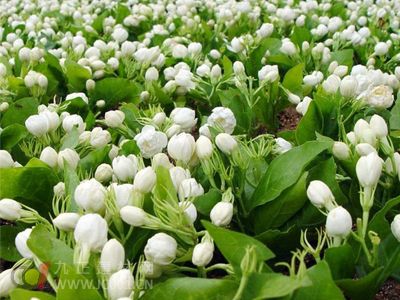Jasmine is white and fragrant, and it blooms from summer to autumn. Among them, from July to August, it is full bloom, and the flowers are large and fragrant. Strengthening the management of flowering period, grasping the control of "water, fertilizer, light", proper pruning, prevention and control of pests and diseases is the key to making the jasmine more floral. 1. Water should be jasmine and moisten the environment. In its flowering period, watering is even more important. Due to the high temperature in summer and the large amount of transpiration of plants, sufficient water should be given. Water should be irrigated once in the morning and evening. In the morning and afternoon, water should be sprayed on the leaves and pots of the plants to enhance the humidity of the air. However, it should be noted that on cloudy and rainy days, watering or watering should be less, and rainy days should also be taken to avoid rain and prevent water in the basin. 2. Fertilizer should be large jasmine in the flowering period, big water and big fertilizer, can be applied once a week rich in liquid fertilizer rich in nitrogen, phosphorus, potassium, if it can be used alternately with hydrazine fertilizer, the effect is better. This not only makes the plant nutrient balance, the leaves are greenish and rich, the flowers are large and fragrant, and it can effectively prevent the occurrence of plant yellowing. 3. Semi-shadowing jasmine is light, and the lack of illumination makes the branches of the plant slender, and the leaves are yellow, but the light is too strong, and it should be properly shaded, otherwise the leaves will be burnt by the sun. Jasmine can be placed in the semi-shade, only to receive light before 9 am and after 5 pm. 4. Skillful pruning jasmine is a new branch flowering, so it should be strengthened in its flowering period, especially pay attention to topping, and the branches of flowers should be cut short in time to promote multiple collaterals and multiple buds. 5. Anti-disease Jasmine will be harmed by scale insects, red spiders and aphids in the summer. If it occurs, the number can be artificially captured when the number is small. When the quantity is large, the shell can be sprayed with 40% omethoate emulsifiable concentrate 1000 times. Insects and aphids, sprayed with 20% chlorfluazol emulsifiable concentrate 1000 times. Jasmine is vulnerable to leaf spot disease in summer, and it can be sprayed with 75% chlorothalonil 800 times when it occurs.
Feed additive is a small amount or a small amount of material added in the process of feed production, processing and use. Feed additive is a Raw Material for modern feed industry must use for strengthening basic feed nutritional value, improve animal production performance, guarantee the animal health, save feed costs, improve quality of animal products and other aspects have obvious effect.
Feed Additives are divided into Microbial Feed Additives and Chinese Herbal Feed Additives. Among them, the microbial feed additive is a kind of microbial product that replaces or balances one or more bacterial strains in the animal ecosystem. In a narrow sense, it is a kind of microbial product that can stimulate the growth of beneficial bacteria and resist the growth of harmful bacteria. Microbial feed Additives containing a large amount of beneficial bacteria (active lactobacillus, bifidobacterium, bacillus), compound enzyme, chelating peptide, mildew remover, etc., as the inside of livestock and poultry feed, can rapid reproduction, on the one hand, into the bacterial metabolites and gut endotoxin inhibits the growth of other harmful flora, on the other hand, it formed the normal microbial flora in the host, synthesis of main vitamin for host, provide nutrition and prevent the invasion of pathogenic bacteria.
Feed Additives Feed Additives,Feed Additive Sulfobetaine,Herbal Feed Additives,Microbial Feed Additives SHANDONG ZHISHANG CHEMICAL CO.LTD , http://www.zhishangchemical.com